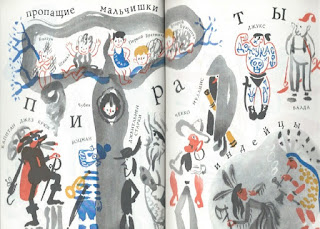Now I cringe, as I've learned its premise is based almost entirely upon misconceptions, including the fact that its central conceit is, well, wrong. Participants are not only talking like Hollywood pirates, not real ones, but like a single actor in particular: Robert Newton. He exaggerated his own English West Country accent for the part of Long John Silver in the 1950 Treasure Island film and an additional 1954 Long John Silver movie for Disney that spun off into a 26-episode TV series. He also played leading role in 1952's Blackbeard the Pirate. Yes, the West Country produced a number of well-known pirates, Henry Every in particular, but so did many other parts of England and the rest of the world.
 |
| Robert Newton with Bobby Driscoll in a publicity shot for the 1950 film Treasure Island |
Slate has a nice discussion of how pirates actually talked, and whether they actually said "aaarrr." (Short answer: No.)
Many of the terms we now associate with pirates weren't even used by them or during the era they made famous. Grog, for example,is a Royal Navy term: 1760-70; from Old Grog (alluding to his grogram cloak), the nickname of Edward Vernon (died 1757), British admiral, who in 1740 ordered the alcoholic mixture to be served, instead of pure spirits, to sailors. It was also coined 30 years after the heyday of the Caribbean pirates.
Learning more about TLAPD has just made me more discouraged. Its founders were Oregonians John Baur and Mark Summers, who title themselves Ol' Chumbucket and Cap'n Slappy. It was an in-joke between them until they wrote a letter about their idea to comic Dave Barry in 2002, and he promoted the idea in his column. Yes, that Dave Barry, he who with Ridley Scott so besmirched the character of Captain Hook and the other Jolly Roger pirates in their Peter and the Starcatchers books. I loved Barry's humor columns when I was growing up, but I've got a bone to pick with him now.
Perhaps I'm losing my sense of humor. But when Facebook and Krispy Kreme are jumping on board (so to speak), maybe the joke has run its course. (To be fair, I suppose Long John Silver's restaurants didn't have much of a choice.)
 |
| Walking the plank happened probably once. It makes a good threat, though. |
One of the themes of The Stowaway is the many-layered nature of truth, which is not served by simplification or the few selected details of a story presented for the stage. Talk Like a Pirate Day serves to make comedy of people and a way of life which were not comic in the least, and ignores much of the colorful realities that make pirates fascinating to the current day--including a level of violence that would shock even our media-soaked society. I'm finding this level of fictionalization increasingly hard to forgive. And no, a doughnut won't help.











